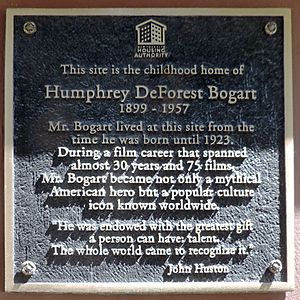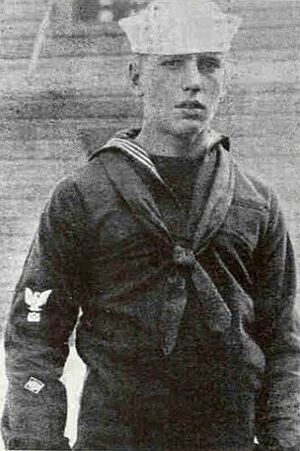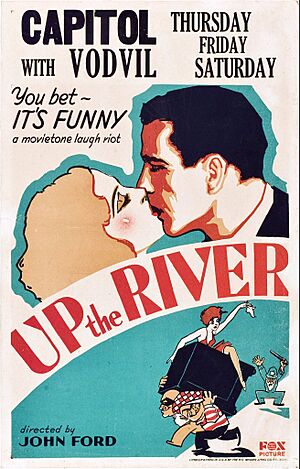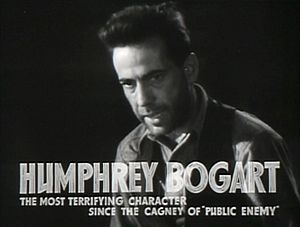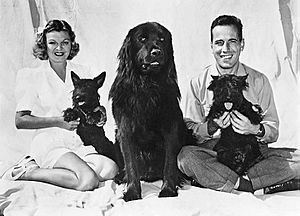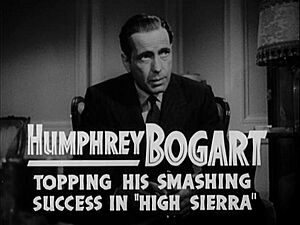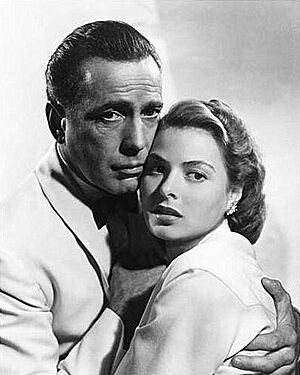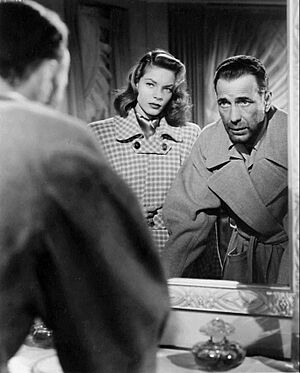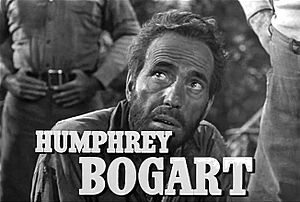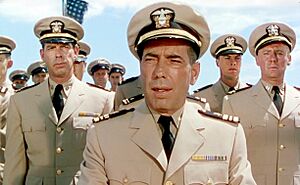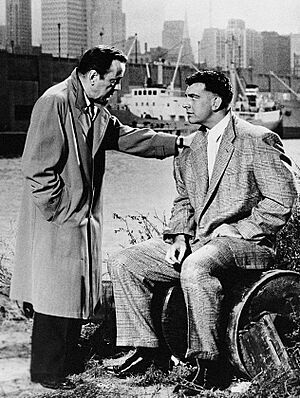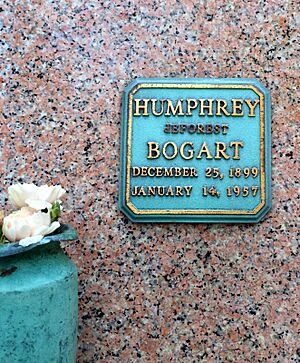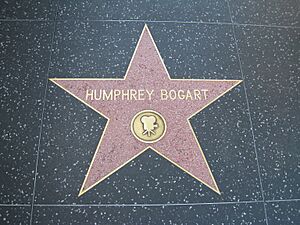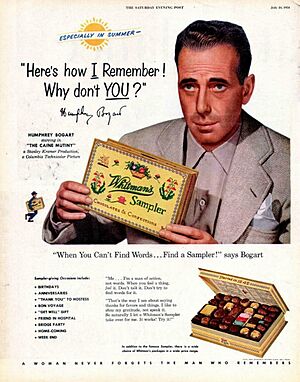Humphrey Bogart facts for kids
Quick facts for kids
Humphrey Bogart
|
|
|---|---|
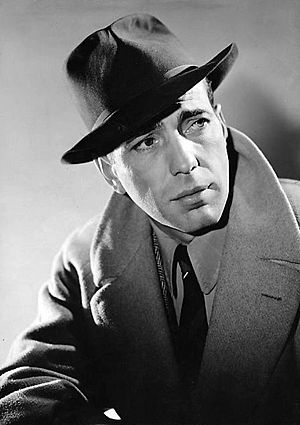
Bogart in 1940
|
|
| Born |
Humphrey DeForest Bogart
December 25, 1899 New York City, U.S.
|
| Died | January 14, 1957 (aged 57) Los Angeles, California, U.S.
|
| Resting place | Forest Lawn Memorial Park, Glendale, California |
| Occupation | Actor |
| Years active | 1921–1956 |
| Political party | Democratic |
| Spouse(s) |
Mary Philips
(m. 1928; div. 1937)Mayo Methot
(m. 1938; div. 1945) |
| Children | 2, including Stephen Humphrey |
| Parent(s) |
|
| Awards | Best Actor 1952 The African Queen |
| Military career | |
| Service/ |
United States Navy |
| Years of service | 1918–1919 |
| Battles/wars | World War I |
| Signature | |
Humphrey DeForest Bogart (born December 25, 1899 – died January 14, 1957), known by his nickname Bogie, was a famous American actor. He starred in many classic Hollywood movies. His performances made him a true American icon. In 1999, the American Film Institute named Bogart the greatest male star in classic American cinema history.
Bogart started his acting career in Broadway shows. He began making movies in 1930 with Up the River. For the next ten years, he often played supporting roles, especially as gangsters. He became famous for playing Duke Mantee in The Petrified Forest (1936). His big break came with High Sierra (1941). He then became a major star in The Maltese Falcon (1941). This movie is considered one of the first great noir films.
Bogart's roles as private detectives, like Sam Spade and Philip Marlowe, became models for future detective movies. He played his most important romantic lead role with Ingrid Bergman in Casablanca (1942). This film earned him his first nomination for an Academy Award for Best Actor. Bogart later fell in love with 19-year-old Lauren Bacall while filming To Have and Have Not (1944). They married in 1945. After their marriage, they starred together in Dark Passage (1947) and Key Largo (1948).
Bogart's performances in The Treasure of the Sierra Madre (1948) and In a Lonely Place (1950) are now seen as some of his best. He won the Academy Award for Best Actor for his role in the adventure film The African Queen (1951). He also received another Best Actor nomination for The Caine Mutiny (1954). Bogart passed away in January 1957 after a long illness.
Contents
Early Life and School
Humphrey DeForest Bogart was born on Christmas Day in 1899 in New York City. He was the oldest child of Belmont DeForest Bogart and Maud Humphrey. His father, Belmont, was a surgeon. His mother, Maud, was a talented commercial illustrator. She even used a drawing of baby Humphrey in an advertisement for Mellins Baby Food. At the peak of her career, Maud earned a lot of money, much more than her husband.
The Bogarts lived in a nice apartment in New York City. They also had a cottage on a large property in upstate New York. When Humphrey was young, he and his friends would put on plays at the lake.
Humphrey had two younger sisters, Frances and Catherine. His parents were very busy with their careers and often argued. They were quite formal and did not show much emotion to their children. Bogart remembered that a kiss in their family was a rare event.
As a boy, Bogart was sometimes teased for his curly hair and the "cute" pictures his mother made him pose for. He also wore fancy clothes that his mother picked out. He inherited a love for fishing and boating from his father. He also seemed to be drawn to strong-willed women.
Bogart went to private schools, including the prestigious Trinity School. He was not a very interested student and didn't join many after-school activities. He later attended Phillips Academy, a boarding school. His parents hoped he would go to Yale University. However, Bogart left Phillips in 1918 after one semester. He struggled with his grades and did not follow all the school rules. His parents were very disappointed.
With no clear plans for his future, Bogart joined the United States Navy in the spring of 1918. This was during World War I. He served as a coxswain. Bogart was considered a good sailor. After the war ended, he spent most of his time helping to bring troops back from Europe. He left the Navy in June 1919.
During World War II, Bogart tried to join the Navy again, but he was too old. Instead, he volunteered for the Coast Guard Temporary Reserve in 1944. He helped patrol the California coastline in his own yacht, the Santana.
Bogart had a famous scar on his lip and a unique way of speaking. There are different stories about how he got his lip scar. Some stories say it happened during his time in the Navy. However, his Navy records after his service did not mention a lip scar. It is believed that the stories about his scar from wartime were made up by the movie studios.
Becoming an Actor
First Roles
When Bogart returned home from the Navy, his father was not well. The family had also lost a lot of money. Bogart had changed during his time in the Navy. He became a liberal person who disliked people who were fake or snobby. He was also polite, clear-spoken, and always on time.
After his Navy service, he worked in shipping and as a salesman. He also joined the Coast Guard Reserve. Bogart became friends again with Bill Brady Jr., whose father had connections in show business. Bogart got an office job with William A. Brady's new film company. He wanted to try writing or directing movies, but he wasn't very good at those jobs.
Bogart became a stage manager for Brady's daughter, Alice Brady, in a play. A few months later, he made his first appearance on stage in Alice's 1921 play Drifting. He had only one line to say. He appeared in several more of her plays.
Bogart had been taught that acting was not a respected job. However, he liked the late hours actors kept and the attention they received. He never took acting lessons. Instead, he learned by doing. Bogart worked steadily, appearing in at least 17 Broadway plays between 1922 and 1935. He often played young, romantic roles in comedies. He was even the first actor to say, "Tennis, anyone?" on stage.
Some critics were not impressed with his early performances. However, others praised his work. He played a reporter in the comedy Meet the Wife, which ran for a successful 232 performances. Bogart didn't like these early roles, calling them "White Pants Willie" parts because they were often trivial and not very manly.
In 1922, he met actress Helen Menken while working on the play Drifting. They married in 1926 but divorced in 1927. They remained friends. Helen said Bogart cared more about his career than their marriage. He then married actress Mary Philips in 1928. They had worked together in a play called Nerves.
After the Wall Street Crash of 1929, fewer plays were being produced. Many actors who looked good on camera moved to Hollywood. Bogart made his film debut in 1928 in a short film called The Dancing Town. He also appeared in another short film, Broadway's Like That (1930).
From Broadway to Hollywood
Bogart signed a contract with Fox Film Corporation. There, he met Spencer Tracy, another Broadway actor. They became close friends. In 1930, Tracy first called him "Bogie." Tracy and Bogart made their first feature film together, Up the River (1930). They played inmates in the movie. Tracy was listed first in the credits, but Bogart's picture appeared on the film's posters.
Bogart then had a supporting role in Bad Sister (1931) with Bette Davis. From 1930 to 1935, Bogart traveled between Hollywood and New York. He was often out of work for long periods. His parents had separated, and his father died in 1934 with debts that Bogart eventually paid off. Bogart inherited his father's gold ring, which he wore in many of his films.
Permanent Move to Hollywood: The Petrified Forest
In 1934, Bogart starred in a Broadway play called Invitation to a Murder. The producer, Arthur Hopkins, then offered him the role of an escaped murderer named Duke Mantee in a new play, The Petrified Forest.
The play was very successful in New York in 1935. Even though Leslie Howard was the main star, critics praised Bogart's performance. Bogart felt this role changed his career. Warner Bros. bought the rights to make The Petrified Forest into a movie in 1935. They wanted Edward G. Robinson for the role of Duke Mantee. However, Leslie Howard, who owned the rights to the play, insisted that Bogart play the part. Howard told Warner Bros. that if Bogart wasn't in the movie, there would be no deal. Warner Bros. agreed.
Jack Warner, the studio head, wanted Bogart to use a different stage name. But Bogart refused, as he had already made a name for himself on Broadway. The film version of The Petrified Forest was released in 1936. Critics praised Bogart's performance. The movie was a box office success and made Bogart a star. He never forgot Leslie Howard's help. He later named his only daughter, Leslie Howard Bogart, after him.
Playing Gangsters and Villains
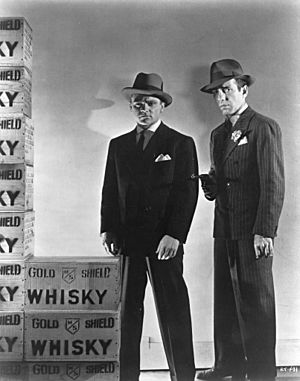
Even after his success in The Petrified Forest, Bogart signed a contract that paid him less than other stars. He was often cast as a gangster in many crime dramas. He was proud of his success, but he found playing only gangster roles tiring. He once said, "Nobody likes me on sight. I suppose that's why I'm cast as the heavy."
Warner Bros. didn't try to make Bogart a bigger star. His roles were often the same and physically demanding. Studios were not yet air-conditioned, and his work schedule was very busy. Even though Bogart didn't like all the roles he was given, he worked constantly. He made a movie every two months between 1936 and 1940. During these years, he started to develop his famous on-screen personality: a tough, quiet, charming, and sometimes lonely character with his own sense of right and wrong.
Bogart often wore his own suits in his films because he thought the studio's costumes were cheap. He also chose his own dog, Zero, to play a character's dog in High Sierra. He often argued with Warner Bros. about his roles and pay.
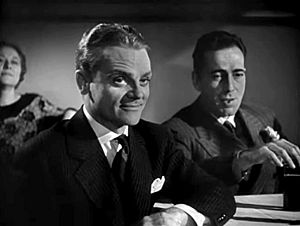
Other leading actors at Warner Bros. included George Raft, James Cagney, and Edward G. Robinson. Most of the best scripts went to them. Bogart was left with films like San Quentin (1937) and Racket Busters (1938). His only main role during this time was in Dead End (1937), where he played a gangster.
Bogart played violent roles so often that people started to connect him with them. He also played different supporting roles, like in Angels with Dirty Faces (1938). In Black Legion (1937), he played a good man who gets caught up in a racist group.
His second marriage to Mary Philips was difficult. She wanted to continue her Broadway career in New York, and they divorced in 1937.
On August 21, 1938, Bogart married actress Mayo Methot. Their marriage was very stormy, and the newspapers called them "the Battling Bogarts." Bogart bought a motor launch and named it Sluggy, which was his nickname for Methot.
Bogart disliked fake people and bad movies. He rarely watched his own films and avoided movie premieres. He would sometimes make up stories about his private life for the newspapers. He also spoke out publicly if he thought an actor, director, or studio did something poorly. This made him not the most popular actor in Hollywood.
Becoming a Star
High Sierra
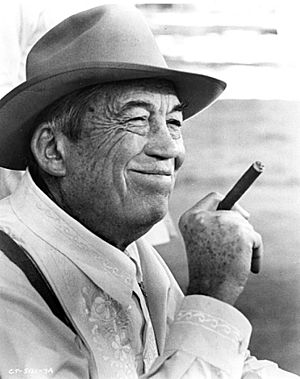
High Sierra (1941) was directed by Raoul Walsh. The script was written by John Huston, who was Bogart's friend. Other actors like Paul Muni and George Raft turned down the main role. This gave Bogart the chance to play a character with more depth. This was Bogart's last major film where he played a gangster.
This film created a strong bond between Bogart and Huston. Bogart admired Huston's writing skills. Bogart was a poor student, but he loved to read. He could quote famous writers like Plato and Shakespeare. He enjoyed deep conversations, just like Huston. Both were rebellious and liked to play jokes.
The Maltese Falcon
The Maltese Falcon (1941) was John Huston's first movie as a director. It is now considered a classic film noir. The movie was based on a novel by Dashiell Hammett. Producer Hal B. Wallis first offered the main role to George Raft. But Raft turned it down, and Huston was happy to cast Bogart as his character, Sam Spade.
Bogart starred with talented actors like Sydney Greenstreet, Peter Lorre, and Mary Astor. Everyone praised Bogart's sharp timing and expressions. The film was a big success and a major win for Huston. Bogart was very happy with the movie, calling it "practically a masterpiece."
Casablanca
Bogart played his first romantic lead role in Casablanca (1942). He played Rick Blaine, a nightclub owner with a mysterious past. He had to deal with Nazis, the French underground, and his feelings for his ex-girlfriend. The film also starred Ingrid Bergman, Claude Rains, and Paul Henreid.
Bogart and Bergman's on-screen chemistry was due to their professionalism. Off-screen, they hardly spoke. Bergman later said about Bogart, "I kissed him but I never knew him." Bogart had to wear special blocks on his shoes in some scenes because Bergman was taller than him.
Bogart was a skilled chess player in real life. He often played games with the film crew. He suggested that his character, Rick Blaine, should also be a chess player.
Casablanca won the Academy Award for Best Picture in 1943. Bogart was nominated for Best Actor, but he did not win. However, the film made Bogart the top star at Warner Bros., finally surpassing James Cagney. His yearly salary more than doubled, making him the highest-paid actor in the world by 1946.
Bogart went on tours to support the troops and sell War Bonds in 1943 and 1944. He traveled to Italy and North Africa, including Casablanca. He still had to act in films with weak scripts, which caused arguments with the studio.
Bogart and Bacall
To Have and Have Not
Howard Hawks introduced Bogart to Lauren Bacall (1924–2014) while Bogart was filming Passage to Marseille (1944). The three then worked together on To Have and Have Not (1944). This movie was loosely based on an Ernest Hemingway novel and was Bacall's first film. It had some similarities to Casablanca, including a piano player. When they met, Bacall was 19 and Bogart was 44. He nicknamed her "Baby."
Bogart was drawn to Bacall's looks and her honest personality. He reportedly said, "I just saw your test. We'll have a lot of fun together." Their connection was strong from the start. Bogart helped Bacall feel comfortable during filming. He encouraged her to shine in her scenes.
However, Howard Hawks, the director, started to dislike their relationship. He felt he was Bacall's mentor, and Bogart was taking that role. Hawks also developed feelings for Bacall. He told her that Bogart didn't truly care for her. Bogart calmed Bacall down and then confronted Hawks. The studio head, Jack Warner, helped settle the argument, and filming continued.
The Big Sleep
A few months after To Have and Have Not, Bogart and Bacall starred together again in the film noir The Big Sleep (1946). This movie was based on a novel by Raymond Chandler. Chandler admired Bogart's acting, saying he "can be tough without a gun."
The film was finished in 1945 but was re-edited to add more scenes with Bogart and Bacall. This was done to take advantage of their popularity after To Have and Have Not and the news about their relationship. The film was successful, even though some critics found its plot confusing.
Marriage
Bogart divorced his third wife, Mayo Methot, in February 1945. He and Bacall married in a small ceremony on May 21, 1945. The wedding took place at the country home of Bogart's friend, author Louis Bromfield, in Ohio.
They moved into a large white brick mansion in an exclusive neighborhood in Los Angeles. Their marriage was mostly happy, but it had its challenges. Bogart enjoyed staying home, while Bacall liked going out. He loved the sea, but she often got seasick. Bacall later said that Bogart told her, "If you want a career more than anything, I will do everything I can to help you... but I will not marry you." She agreed to prioritize their marriage, and she was glad she did.
Bogart bought a 55-foot sailing yacht called the Santana in 1945. He found peace at sea and spent about thirty weekends a year sailing around Catalina Island. He believed that actors needed something to keep them grounded and true to themselves. Bogart joined the Coast Guard Temporary Reserve. He offered the Coast Guard use of his yacht.
Dark Passage and Key Largo
Dark Passage (1947) was Bogart and Bacall's next movie together. Bogart played a character trying to find the real murderer of a crime he was wrongly accused of.
Bogart and Bacall's last film together was Key Largo (1948). It was directed by John Huston. Edward G. Robinson played a gangster in the film. The movie's characters are trapped in a hotel during a hurricane. Claire Trevor won an Academy Award for Best Supporting Actress for her role as the gangster's girlfriend.
Later Career
The Treasure of the Sierra Madre
In 1947, Bogart signed a new contract that allowed him to choose his scripts and form his own production company. He reunited with John Huston for The Treasure of the Sierra Madre. This was a story about three gold prospectors in Mexico and their greed. It was considered a risky film because it didn't have a love story or a happy ending. Bogart said about his co-star, Walter Huston (John Huston's father), "He's probably the only performer in Hollywood to whom I'd gladly lose a scene."
The film was difficult to make, shot in the summer heat for realism. Critics praised Bogart's performance. John Huston won an Academy Award for Best Director and screenplay, and his father won Best Supporting Actor. However, the film did not do well at the box office. Bogart complained that the public didn't appreciate an intelligent and different film.
House Un-American Activities Committee
Bogart was a liberal Democrat. He helped organize the Committee for the First Amendment. This group went to Washington, D.C., to protest against the House Un-American Activities Committee. This committee was investigating Hollywood screenwriters and actors. Bogart later wrote an article called "I'm No Communist" to clarify his position.
Santana Productions
Bogart started his own film company, Santana Productions, in 1948. He named it after his yacht. The right to create his own company made the studio head, Jack Warner, very angry. He worried that other stars would do the same. Bogart appeared in his final films for Warner Bros., Chain Lightning (1950) and The Enforcer (1951).
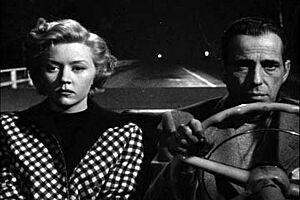
Santana Productions released its films through Columbia Pictures. Bogart quickly starred in several films, including Knock on Any Door (1949), Tokyo Joe (1949), In a Lonely Place (1950), and Sirocco (1951).
Most of these films did not make money at the box office, which eventually led to Santana being sold. However, In a Lonely Place is still considered a great film noir. Bogart played Dixon Steele, a writer with a reputation for violence. Many people, including Bogart's biographers, felt that this role was very close to the real Bogart.
Beat the Devil (1953) was the last film for Bogart and John Huston. It was co-written by Truman Capote. The story follows a group of dishonest characters chasing a treasure. Bogart sold his share in Santana to Columbia in 1955.
The African Queen
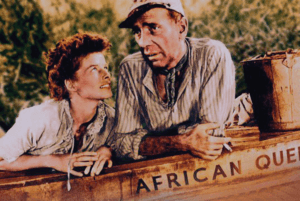
Outside of Santana Productions, Bogart starred with Katharine Hepburn in the John Huston-directed film The African Queen in 1951. The story was based on a novel by C. S. Forester. Producer Sam Spiegel and Huston bought the rights to the book. Katharine Hepburn suggested Bogart for the male lead. She believed he was the only actor who could play the part.
Huston's love for adventure, his friendship with Bogart, and the chance to work with Hepburn convinced Bogart to film in the Belgian Congo. This was a difficult location. Bogart was to receive 30 percent of the film's profits.
Bacall came along for the four-month filming, leaving their young son in Los Angeles. The Bogarts started their trip with a tour through Europe, including a visit with Pope Pius XII. Bacall helped out by cooking, nursing, and washing clothes. Almost everyone in the cast got sick except Bogart and Huston. They ate only canned food. Bogart joked, "Whenever a fly bit Huston or me, it dropped dead." Hepburn had a harder time with the difficult conditions and became very ill.
The film crew faced many challenges, including illness, ant infestations, leaky boats, bad food, attacking hippos, and extreme heat. Despite the difficulties, they completed the film. The African Queen seemed to bring back Bogart's early love for boats. When he returned to California, he bought a classic mahogany boat.
His performance as the grumpy skipper Charlie Allnutt earned Bogart an Academy Award for Best Actor in 1951. This was his only Oscar win out of three nominations. He considered it the best performance of his film career. When he won, he thanked John Huston and Katharine Hepburn for helping him. The African Queen was Bogart's first main role in Technicolor.
The Caine Mutiny
Bogart lowered his usual fee to play Captain Queeg in Edward Dmytryk's drama, The Caine Mutiny (1954). He gave a strong performance in the lead role. He received his final Oscar nomination for this film. He was also featured on the cover of Time magazine in June 1954.
Despite his success, Bogart was still sometimes unhappy. He argued with the studio, and his health began to get worse. Bogart's character, Queeg, was a paranoid and self-pitying person whose small-mindedness eventually led to his downfall.
Final Roles
For Sabrina (1954), director Billy Wilder wanted Cary Grant for the older male lead. He chose Bogart to play the serious brother who competes with his younger sibling (William Holden) for the affection of Sabrina (Audrey Hepburn). Bogart wasn't very excited about the role. He agreed to it based on a handshake with Wilder, who promised to take good care of him during filming.
However, Bogart did not get along well with the director or his co-stars. He complained about the script being written at the last minute. He also accused Wilder of favoring Hepburn and Holden. Wilder later said, "We parted as enemies but finally made up." Despite the disagreements, the film was successful. Critics praised Bogart's skilled performance.
Joseph L. Mankiewicz's The Barefoot Contessa (1954) was filmed in Rome. In this movie, Bogart plays a cynical director who saves his career by making a star out of a flamenco dancer. He was uncomfortable with Ava Gardner in the female lead role. He was also annoyed by her lack of experience. Bogart's performance was generally praised as the strongest part of the film.
Bogart was often generous with other actors, especially those who were having problems. During the filming of The Left Hand of God (1955), he noticed his co-star Gene Tierney having trouble remembering her lines. He helped her and encouraged her to get treatment. He also supported Joan Bennett and insisted she be his co-star in We're No Angels (1955).
Bogart had already been diagnosed with a serious illness when he filmed The Harder They Fall, a boxing drama, in 1956.
Television and Radio
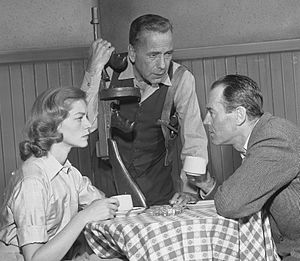
Bogart rarely appeared on television. However, he and Bacall were on Edward R. Murrow's Person to Person show. He also appeared on The Jack Benny Show in 1953.
Bogart and Bacall worked on an early color television broadcast in 1955. It was an NBC adaptation of "The Petrified Forest" for Producers' Showcase. Bogart had the main role, Henry Fonda played Leslie Howard's part, and Bacall played Bette Davis's part.
Bogart also performed in radio versions of his famous films, like Casablanca and The Maltese Falcon. He also recorded a radio series called Bold Venture with Bacall.
Personal Life
Children
Bogart became a father at age 49. His son, Stephen Humphrey Bogart, was born on January 6, 1949. His name came from Steve, Bogart's character's nickname in To Have and Have Not. Stephen later became an author. The couple's daughter, Leslie Howard Bogart, was born on August 23, 1952. Her first and middle names honored Leslie Howard, Bogart's friend and co-star from The Petrified Forest.
The Rat Pack
Bogart was a founding member and the first leader of the Hollywood Rat Pack. In the spring of 1955, after a long party in Las Vegas, Bacall looked at the group and said, "You look like a rat pack."
The name stuck and became official. Frank Sinatra was called the pack president, Bacall was the den mother, and Bogart was the director of public relations. When asked what the group's purpose was, Bacall replied, "To drink a lot of bourbon and stay up late."
Illness and Passing
In 1955, Bogart's health began to decline. He had plans for a new film, but his persistent cough and difficulty eating became too serious. He dropped out of the project.
Bogart had developed a serious illness. He did not talk about his health. He finally visited a doctor in January 1956 after Bacall convinced him. The illness worsened. On March 1, Bogart had surgery. The surgery was not successful, and he received further treatment. He had another surgery in November 1956.
Although he became too weak to walk, he still joked. Frank Sinatra, Katharine Hepburn, and Spencer Tracy visited him on January 13, 1957. Bogart passed away the next day, January 14, 1957, at the age of 57.
A simple funeral was held at All Saints Episcopal Church. Many of Hollywood's biggest stars attended. Bogart was cremated. His ashes were placed in Forest Lawn Memorial Park in Glendale, California. He was buried with a small, gold whistle that he had given to Bacall before they married. It had the words, "If you want anything, just whistle." This was a reference to a famous line from their movie To Have and Have Not.
Awards and Honors
On August 21, 1946, Humphrey Bogart placed his hand and footprints in cement at Grauman's Chinese Theatre. On February 8, 1960, Bogart was honored with a star on the Hollywood Walk of Fame. His star is located at 6322 Hollywood Boulevard.
| Year | Award | Film | Result |
|---|---|---|---|
| 1943 | Best Actor | Casablanca | Nominated |
| 1951 | The African Queen | Won | |
| 1954 | The Caine Mutiny | Nominated |
Legacy and Tributes

After his passing, a "Bogie cult" grew in different places, including Cambridge, Massachusetts, and France. This helped make him even more popular in the late 1950s and 1960s. In 1997, Entertainment Weekly magazine ranked Bogart as the number-one movie legend of all time. Two years later, the American Film Institute named him the greatest male screen legend.
Jean-Luc Godard's film Breathless (1960) was the first movie to honor Bogart. Later, in Woody Allen's comedy Play It Again, Sam (1972), Bogart's ghost helps Allen's character.
The United States Postal Service honored Bogart with a stamp in its "Legends of Hollywood" series in 1997. On June 24, 2006, a street in New York City was renamed Humphrey Bogart Place. Lauren Bacall and her son, Stephen Bogart, attended the ceremony.
Filmography
Notable Radio Appearances

| Date | Program | Episode |
|---|---|---|
| April 17, 1939 | Lux Radio Theatre | Bullets or Ballots |
| 1940 | The Gulf Screen Guild Theater | The Petrified Forest |
| January 4, 1942 | The Screen Guild Theater | High Sierra |
| 1943 | The Screen Guild Theater | Casablanca |
| September 20, 1943 | The Screen Guild Theater | The Maltese Falcon |
| 1946 | Lux Radio Theatre | To Have and Have Not |
| April 18, 1949 | Lux Radio Theatre | Treasure of the Sierra Madre |
| 1951–52 | Bold Venture | 78-episode series |
| 1952 | Lux Radio Theatre | The African Queen |
Images for kids
-
Frank McHugh, James Cagney and Bogart in The Roaring Twenties
See Also
 In Spanish: Humphrey Bogart para niños
In Spanish: Humphrey Bogart para niños
- Bogart–Bacall syndrome
- List of actors with Academy Award nominations
- List of amateur chess players
- List of members of the American Legion


